今天我們接著深入解析表單元素中ComboBox組件的使用
5.服務(wù)器數(shù)據(jù)作為ComboBox的數(shù)據(jù)源實(shí)例
首先從服務(wù)器獲取json數(shù)據(jù):
 //cs后臺(tái)代碼,簡(jiǎn)單起見,示例而已,要主要字符串格式(新手注意,下面的代碼放在類里面,不是放在方法里) //cs后臺(tái)代碼,簡(jiǎn)單起見,示例而已,要主要字符串格式(新手注意,下面的代碼放在類里面,不是放在方法里)
 public string ServerData="['湖北','江西','安徽']"; public string ServerData="['湖北','江西','安徽']";
  //aspx前臺(tái)js介紹代碼 //aspx前臺(tái)js介紹代碼
  Ext.onReady(function() Ext.onReady(function() { {
  var combo=new Ext.form.ComboBox( var combo=new Ext.form.ComboBox( { {
 store:<%=ServerData%>,//獲取ServerData的string值,不要用""引起來,否則就不是object數(shù)據(jù),而是字符串,這是一個(gè)很巧妙的關(guān)鍵點(diǎn):把服務(wù)器的字符串轉(zhuǎn)化為js的object數(shù)據(jù),是不是超級(jí)方便。 store:<%=ServerData%>,//獲取ServerData的string值,不要用""引起來,否則就不是object數(shù)據(jù),而是字符串,這是一個(gè)很巧妙的關(guān)鍵點(diǎn):把服務(wù)器的字符串轉(zhuǎn)化為js的object數(shù)據(jù),是不是超級(jí)方便。
 emptyText:'請(qǐng)選擇一個(gè)省份 emptyText:'請(qǐng)選擇一個(gè)省份 .', .',
 applyTo: 'combo' applyTo: 'combo'
 }); });
 }); });
 <input type="text" id="combo" size="20"/> <input type="text" id="combo" size="20"/>

我們就通過<%=ServerData%>這樣的方式獲取到了服務(wù)器最簡(jiǎn)單的屬性數(shù)據(jù)。問題來了,js和html怎么調(diào)用c#后臺(tái)
的變量和方法?(變量的調(diào)用上面剛剛介紹)
7.ComboBox的數(shù)據(jù)源store格式詳解
在前面的例子里面,我們一直給ComboBox的數(shù)據(jù)源store賦值一維數(shù)組,其實(shí)store支持多維和Store.data.Store類型。
 //下面就幾種數(shù)據(jù)以代碼舉例說明 //下面就幾種數(shù)據(jù)以代碼舉例說明
 1.一維數(shù)組:["江西","湖北"],值同時(shí)賦給ComboBox的value和text 1.一維數(shù)組:["江西","湖北"],值同時(shí)賦給ComboBox的value和text
 2.二維和多維數(shù)組:[["one","bbar","111"],["two","tbar","222"]],第一維和第二維分別賦值給value和text,其他維忽略 2.二維和多維數(shù)組:[["one","bbar","111"],["two","tbar","222"]],第一維和第二維分別賦值給value和text,其他維忽略
 3.store類型:包括GroupingStore, JsonStore, SimpleStore. 3.store類型:包括GroupingStore, JsonStore, SimpleStore.
 //我們分三步走: //我們分三步走:
 //第一步:提供數(shù)據(jù): //第一步:提供數(shù)據(jù):
 var data=[['湖北','hubei'],['江西','jiangxi'],['安徽','anhui']]; var data=[['湖北','hubei'],['江西','jiangxi'],['安徽','anhui']];
 //第二步:導(dǎo)入到store中: //第二步:導(dǎo)入到store中:
  var store = new Ext.data.SimpleStore( var store = new Ext.data.SimpleStore( { {
 fields: ['chinese', 'english'], fields: ['chinese', 'english'],
 data : data data : data
 }); });
 //第三步 :把store托付給comboBox的store //第三步 :把store托付給comboBox的store
  var combo = new Ext.form.ComboBox( var combo = new Ext.form.ComboBox( { {
 store: store, store: store,
 displayField:'english',//store字段中你要顯示的字段,多字段必選參數(shù),默認(rèn)當(dāng)mode為remote時(shí)displayField為undefine,當(dāng)select列表時(shí)displayField為"text" displayField:'english',//store字段中你要顯示的字段,多字段必選參數(shù),默認(rèn)當(dāng)mode為remote時(shí)displayField為undefine,當(dāng)select列表時(shí)displayField為"text"
 mode: 'local',//因?yàn)閐ata已經(jīng)取數(shù)據(jù)到本地了,所以'local',默認(rèn)為"remote",枚舉完 mode: 'local',//因?yàn)閐ata已經(jīng)取數(shù)據(jù)到本地了,所以'local',默認(rèn)為"remote",枚舉完
 emptyText:'請(qǐng)選擇一個(gè)省份 emptyText:'請(qǐng)選擇一個(gè)省份 ', ',
 applyTo: 'combo' applyTo: 'combo'
 }); });
8.ComboBox的value獲取
 //ComboBox的事件很多(api),我們無法一一講解,但是我們可以舉一反三,select事件就是其中典型的一個(gè) //ComboBox的事件很多(api),我們無法一一講解,但是我們可以舉一反三,select事件就是其中典型的一個(gè)
  listeners: listeners: { {
  "select":function() "select":function() { {
 alert(Ext.get("combo").dom.value); //獲取id為combo的值 alert(Ext.get("combo").dom.value); //獲取id為combo的值
 } }
 } }
 //這里我們提供了一種不是很好的方法,在此不做過多停留 //這里我們提供了一種不是很好的方法,在此不做過多停留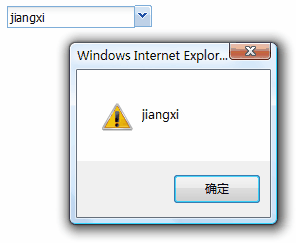
9.把Extjs的ComboBox樣式應(yīng)用到select的下拉框中去
核心參數(shù)介紹
 transform:id//用于轉(zhuǎn)換樣式的,TimeField作為ComboBox的子類也有此屬性 transform:id//用于轉(zhuǎn)換樣式的,TimeField作為ComboBox的子類也有此屬性核心代碼:
 //js代碼 //js代碼
  var ExtSelect=new Ext.form.ComboBox( var ExtSelect=new Ext.form.ComboBox( { {
 transform:"select",//html中的id transform:"select",//html中的id
 width:80//寬度 width:80//寬度
 }); });
 //html代碼 //html代碼
 <select id="select"> <select id="select">
 <option value="1">浪曦</option> <option value="1">浪曦</option>
 <option value="2">博客園</option> <option value="2">博客園</option>
 <option value="3">百度</option> <option value="3">百度</option>
 <option value="4">新浪</option> <option value="4">新浪</option>
 </select> </select>
 //是不是超級(jí)簡(jiǎn)單? //是不是超級(jí)簡(jiǎn)單?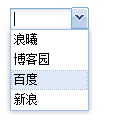  10.ComboBox的其他重要參數(shù)
10.ComboBox的其他重要參數(shù)
1.valueField:"valuefield"//value值字段
2.displayField:"field" //顯示文本字段
3.editable:false//false則不可編輯,默認(rèn)為true
4.triggerAction:"all"//請(qǐng)?jiān)O(shè)置為"all",否則默認(rèn)為"query"的情況下,你選擇某個(gè)值后,再此下拉時(shí),只出現(xiàn)匹配選項(xiàng),如果設(shè)為"all"的話,每次下拉均顯示全部選項(xiàng)
5.hiddenName:string //真正提交時(shí)此combo的name,請(qǐng)一定要注意
6.typeAhead:true,//延時(shí)查詢,與下面的參數(shù)配合
7.typeAheadDelay:3000,//默認(rèn)250
//其他參數(shù),請(qǐng)參考api,或自行嘗試
11.checkbox簡(jiǎn)單示例

  Ext.onReady(function() Ext.onReady(function() { {
 Ext.QuickTips.init(); Ext.QuickTips.init();
  var myform=new Ext.FormPanel( var myform=new Ext.FormPanel( { {
 frame:true, frame:true,
 width:330, width:330,
 layout:"form", layout:"form",
 labelWidth:30, labelWidth:30,
 title:"checkbox簡(jiǎn)單示例", title:"checkbox簡(jiǎn)單示例",
 labelAlign:"left", labelAlign:"left",
 renderTo:Ext.getBody(), renderTo:Ext.getBody(),
  items:[ items:[ { {
 xtype:"panel", xtype:"panel",
 layout:"column",//也可以是table,實(shí)現(xiàn)多列布局 layout:"column",//也可以是table,實(shí)現(xiàn)多列布局
 fieldLabel:'愛好', fieldLabel:'愛好',
 isFormField:true,//非常重要,否則panel默認(rèn)不顯示fieldLabel isFormField:true,//非常重要,否則panel默認(rèn)不顯示fieldLabel
  items:[ items:[ { {
 columnWidth:.5,//寬度為50% columnWidth:.5,//寬度為50%
 xtype:"checkbox", xtype:"checkbox",
 boxLabel:"足球",//顯示在復(fù)選框右邊的文字 boxLabel:"足球",//顯示在復(fù)選框右邊的文字
 name:"" name:""
  }, }, { {
 columnWidth:.5, columnWidth:.5,
 xtype:"checkbox", xtype:"checkbox",
 boxLabel:"籃球", boxLabel:"籃球",
 name:"" name:""
 }] }]
 }] }]
 }); });
 }); });
關(guān)于多列布局,我們可以使用column或者table布局解決!
//其他幾個(gè)參數(shù)
1.checked:true//true則選中,默認(rèn)為false
2.name:"**"//name值
3.value:""//初始化值,默認(rèn)為undefine
12.radio簡(jiǎn)單示例
基本上和checkbox一樣,不過注意一組單選框必須name值相同,才能單選。

 //基本同上,不做過多解釋 //基本同上,不做過多解釋
  Ext.onReady(function() Ext.onReady(function() { {
 Ext.QuickTips.init(); Ext.QuickTips.init();
  var myform=new Ext.FormPanel( var myform=new Ext.FormPanel( { {
 frame:true, frame:true,
 width:330, width:330,
 layout:"form", layout:"form",
 labelWidth:30, labelWidth:30,
 title:"radio簡(jiǎn)單示例", title:"radio簡(jiǎn)單示例",
 labelAlign:"left", labelAlign:"left",
 renderTo:Ext.getBody(), renderTo:Ext.getBody(),
  items:[ items:[ { {
 xtype:"panel", xtype:"panel",
 layout:"column", layout:"column",
 fieldLabel:'性別', fieldLabel:'性別',
 isFormField:true, isFormField:true,
  items:[ items:[ { {
 columnWidth:.5, columnWidth:.5,
 xtype:"radio", xtype:"radio",
 boxLabel:"男", boxLabel:"男",
 name:"sex" name:"sex"
 //inputValue //inputValue
  }, }, { {
 columnWidth:.5, columnWidth:.5,
 checked:true, checked:true,
 xtype:"radio", xtype:"radio",
 boxLabel:"女", boxLabel:"女",
 name:"sex" name:"sex"
 }] }]
 }] }]
 }); });
 }); });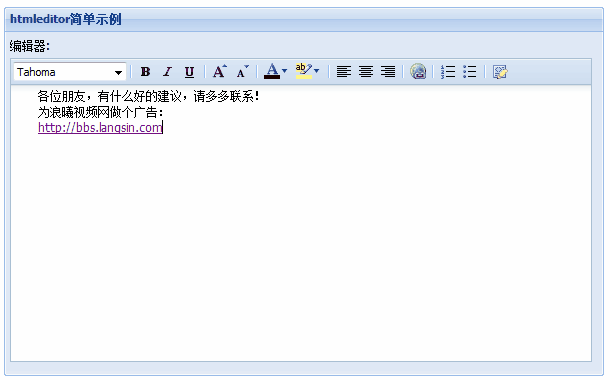
 //基本上同上 //基本上同上
  Ext.onReady(function() Ext.onReady(function() { {
 Ext.QuickTips.init(); Ext.QuickTips.init();
  var myform=new Ext.FormPanel( var myform=new Ext.FormPanel( { {
 frame:true, frame:true,
 width:600, width:600,
 layout:"form", layout:"form",
 labelWidth:50, labelWidth:50,
 title:"htmleditor簡(jiǎn)單示例", title:"htmleditor簡(jiǎn)單示例",
 labelAlign:"top",//items中的標(biāo)簽的位置 labelAlign:"top",//items中的標(biāo)簽的位置
 renderTo:Ext.getBody(), renderTo:Ext.getBody(),
  items:[ items:[ { {
 xtype:"htmleditor", xtype:"htmleditor",
 id:"he", id:"he",
 fieldLabel:"編輯器", fieldLabel:"編輯器",
 anchor:"99%" anchor:"99%"
 }] }]
 }); });
 }); });
在這里我啰嗦個(gè)參數(shù):
//labelAlign參數(shù)
labelAlign:此參數(shù)是指form表單中items各項(xiàng)的label位置,默認(rèn)值為left,枚舉值有l(wèi)eft,right,top
//我看見過有朋友認(rèn)為此參數(shù)指title的位置,是錯(cuò)誤的!
幾個(gè)其他的參數(shù):
//補(bǔ)充幾個(gè)參數(shù)
1.hideLabel:true//默認(rèn)為false,還適用于有標(biāo)簽的所有表單組件
//下面的一組參數(shù)控制編輯器的工具欄選項(xiàng),都是默認(rèn)值為true
2.enableColors:true//默認(rèn)為true,顯示字體顏色,字體背景顏色
3.enableAlignments:true//左,中,右對(duì)齊
4.enableFont:true//字體
5.enableFontSize:false//字體大小,就是A旁邊有個(gè)小箭頭的
6.enableFormat:false//粗體,斜體,下劃線
7.enableLinks:true//鏈接
8.enableLists:true//列表
9.enableSourceEdit:true//源代碼編輯
14.datefield簡(jiǎn)單示例
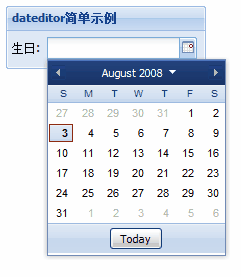
Ext.onReady(function(){
Ext.QuickTips.init();
var myform=new Ext.FormPanel({
frame:true,
width:200,
layout:"form",
labelWidth:30,
title:"dateditor簡(jiǎn)單示例",
labelAlign:"left",
renderTo:Ext.getBody(),
items:[{
xtype:"datefield",
fieldLabel:"生日",
anchor:"99%"
}]
});
});
17.triggerfield簡(jiǎn)單示例
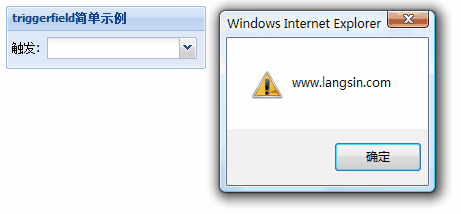
  Ext.onReady(function() Ext.onReady(function() { {
 Ext.QuickTips.init(); Ext.QuickTips.init();
  var myform=new Ext.FormPanel( var myform=new Ext.FormPanel( { {
 frame:true, frame:true,
 width:200, width:200,
 layout:"form", layout:"form",
 labelWidth:30, labelWidth:30,
 title:"triggerfield簡(jiǎn)單示例", title:"triggerfield簡(jiǎn)單示例",
 labelAlign:"left", labelAlign:"left",
 renderTo:Ext.getBody(), renderTo:Ext.getBody(),
  items:[ items:[ { {
 xtype:"trigger", xtype:"trigger",
 fieldLabel:"觸發(fā)", fieldLabel:"觸發(fā)",
 anchor:"99%", anchor:"99%",
  onTriggerClick:function(e) onTriggerClick:function(e) { {
 //在這里寫你要實(shí)現(xiàn)的事件,很容易擴(kuò)展 //在這里寫你要實(shí)現(xiàn)的事件,很容易擴(kuò)展
 alert("www.langsin.com"); alert("www.langsin.com");
 } }
 }] }]
 }); });
 }); });
好了,關(guān)于form的幾個(gè)基本組件我們都蜻蜓點(diǎn)水的看了一遍,相信大家感性上知道是怎么回事啦!(總算快寫完了formpanel)
前面有朋友說要做個(gè)一行多個(gè)控件,中間有文字的那種form布局,謝謝支持!

|